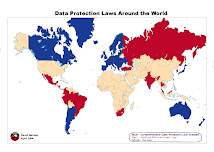As always, CIFAS is giving us food for thought in their annual publication of Fraud Trends. On 1 March 2010,CIFAS will publish Fraudscape 2010: Depicting the UK's Fraud Landscape. This report will look, in depth, at all of the frauds filed by CIFAS Members in 2009 and examine the reasons behind these fraud trends. The report will be available on the CIFAS website and in hard copy. Read on...
____________________________________________________
Fraud continues to demonstrate impact of the recession
The analysis of fraud trends during 2009 by CIFAS - The UK's Fraud Prevention Service - reveals a 9% increase in the overall level of fraud, when compared with the previous year. This rise has been driven by some particular factors, most notably:
the unwelcome return of identity fraud which has led to a 31% escalation in the numbers of victims of fraud
a 55% increase in false insurance claims and a change in the nature of them as the effects of the recession intensify
the relentless rise in facility takeover and misuse of facility frauds.
(Numerical tables are included in the Notes for Editors below).
32% surge in identity fraud
CIFAS commented in October 2009 (in The Anonymous Attacker) on the reappearance of identity fraud (the use of a stolen or false identity to obtain goods or services by deception). This increase has continued; up 32% in 2009 from the level recorded in 2008. This rise has a direct link to the recession. Fraudsters have seen the reduction in the overall amount of lending taking place during 2009, discouraging many from attempting to commit application fraud (e.g. the use of lies and forged documents in an attempt to obtain products or services). This has led to a 25% reduction in application fraud but has meant that they have returned to stealing the identities of others in order to gain products and services.
Protective Registration (a service provided by CIFAS to help protect individuals at heightened risk of identity fraud) increased by 241% year on year. This is attributable both to a developing awareness among individuals of the threat of identity fraud and how it is perpetrated, and to the growing use of the service by organisations to protect the identities of those whose details have been put at risk as a result of a data breach.
Over 25,000 more victims in 2009
With over 85,000 victims of impersonation, and 24,000 victims of takeover (whose accounts have been hijacked by fraudsters) recorded in 2009 (increases of 35% and 16% respectively on 2008 and an overall increase in victims of 31%), the very real impact of fraud is underlined. Fraud victims can be preyed upon by organised criminals, faceless fraudsters and sometimes even by those close to them. Victims commonly describe feelings of helplessness, vulnerability and not knowing who to trust. This is in addition to the financial impact and time taken to rectify the damage.
CIFAS Communications Manager, Richard Hurley, comments: "The financial cost of fraud is bad enough, but the emotional and psychological effects for the victim must never be underestimated. Fraudsters are adapting their approach in an attempt to ensure that their profits do not suffer during the recession, with absolutely no thought for the profoundly damaging impact this has on their victims. The role played by online, organised, criminals trading in people's identity details has been frequently reported in recent years, and it is depressing to think that the numbers of victims of fraud demonstrates just how little these criminals care."
Rise in insurance fraud shows increase in premeditated 'accidents'
While insurance fraud has long been difficult to prove (for instance, adding to claims for stolen cars or laptops other items such as mp3 players, mobile phones, cameras and wallets), the 55% increase in cases filed by CIFAS Members during 2009 reveals a trend towards claimants being even more dishonest. The 55% increase in fraudulent claims is driven more by a surge in claims for staged or completely fictitious events than inflated claims for damage and losses actually incurred.
On 1 March 2010, CIFAS will publish its report Fraudscape 2010: Depicting the UK's Fraud Landscape. This examination of fraud trends will provide a more detailed look at what lies behind the increase in false insurance claims as well as in all other types of fraud identified by CIFAS Members throughout 2009.
Facility takeover fraud and misuse of facility continue to be double trouble
Previous figures from CIFAS have confirmed the intensification during the past two years of facility takeover frauds (also known as 'account takeover' where a fraudster hijacks an individual's account in order to 'take over' and control it) and misuse of facility frauds (where the fraudster uses an account, policy or other facility for a fraudulent purpose such as receiving fraudulent payments into a bank account, or evading payments on credit card or loan accounts).
In 2009, facility takeover fraud rose by 16% from 2008. This means an increase of over 250% during the past 24 months. A significant contributory factor to this trend is the prevalence of 'phishing' emails (sent by fraudsters to look as though they come from a bank or credit card company, for example, asking for personal details which are then used to plunder the victim's account).
Similarly, misuse of facility has risen by 28% in 2009 and by 115% during the last two years.
The link between these types of fraud runs deep, with fraudsters frequently using both methods: for example, taking over an account to withdraw funds and then using another account to receive these bogus 'transactions'. Richard Hurley explains: "Whether it is an organised criminal obtaining your account numbers online, or someone in dire financial straits misusing their cheque-book account, the net result is still fraud: fraud that costs businesses, the public sector, and ultimately all of us, millions of pounds each year."
Comment from the CIFAS Chief Executive
Peter Hurst, CIFAS Chief Executive, comments: "It is well-known that a rise in fraud goes hand in hand with a recession. The trends identified by CIFAS Members during 2009, however, demonstrate that it is not just a few thousand extra people turning to crime to make ends meet. It is a whole criminal element changing its behaviour. Fraudsters adapt their methods in response to changes in the economy, finding and exploiting any area of weakness.
"All organisations must acknowledge this by arming themselves against the fraudsters. As these figures demonstrate, fraud is very much a present danger - no matter what the circumstances. Working together, sharing data on proven frauds and sharing best practice are the only ways that fraud can be prevented - and it is not only the pragmatic thing to do, but also the responsible thing to do in times of continued economic strife."
Monday 22 February 2010
Subscribe to:
Posts (Atom)



